How To Get Started With Hammock Camping – For Beginners!
Hammock camping is the ultimate lightweight adventure. With minimal gear, you can set up camp in seconds and sleep comfortably over any terrain.
In this article, we’re going to cover everything you need to know about hammock camping. Including how to get the most comfortable sleep, the essential gear to pack, and tips for your first hang.
Our favorite all-in-one hammock camping kits:
- 4 lbs 3 oz
- 400 lb weight capacity
- 30 adjustment points, no knots required
- 1% of proceeds go to environmental protection
- 3 lbs 3 oz
- 300 lb weight capacity
- Versatile design; can be used as a ground tent
Hammock Camping vs Tent Camping
There are a lot of reasons to go hammock camping rather than pack a tent. For one, hammocks are impressively lightweight.
- Lightweight: With a smaller footprint and fewer materials than a tent, hammocks are convenient to pack. This makes them ideal for backpackers, kayak campers, and anyone who just wants to hang at the campsite.
- Convenient: Hammocks allow you to camp over uneven terrain, rocks, streams, and thick vegetation. The set up has minimal impact on the environment reducing damage to trees and ground cover.
- Fast set up: While multiple straps and cords may seem intimidating, once you get the hang of it, hammocks are faster to assemble than a traditional tent. Even in places with no trees, you can find suitable solutions to hanging a hammock.
- Customizable: The components of a tent cannot be changed for the most part. Tarps, poles, and rainflys are sized to match. With a hammock, however, you can easily mix and match modules to suit your trip. Under quilts, rainflys, and even straps can be combined to create the most comfortable experience.
- Clean: Sleeping off the ground in a hammock will keep you isolated from bugs, pools of water, dirt, and mud. The hammock will remain clean throughout the night leading to a quick disassembly in the morning.
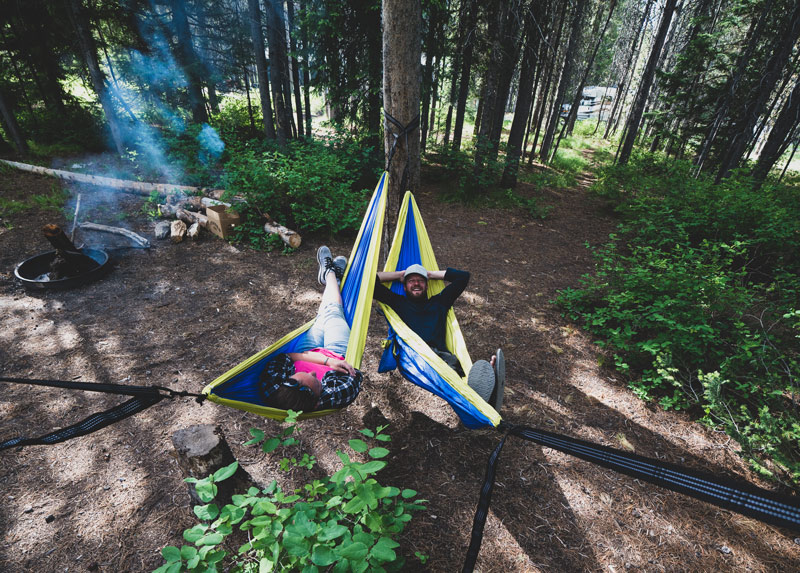
Who should go hammock camping?
If camping is a regular summer activity for you, nothing beats spending the night in a hammock for the first time. Everyone could benefit from some hammock comfort. However, some campers, in particular, may enjoy the advantages more than others:
- Backpackers and thru-hikers
- Kayak and canoe campers
- Rock climbers
- Bicycle and motorcycle campers
What are the downsides to hammock camping?
Every sleep apparatus is going to have its downsides and hammocks are no different.
- There is a learning curve.
Perhaps the biggest complaint that campers have is that hammocks are uncomfortable. But most discomfort comes from an improper hang. Choosing trees that are too close together, laying at the wrong angle, or tying your hammock too tight can all contribute to discomfort.
Later in this article, we’re going to give you some advice on how to sleep in a hammock comfortably, and how to set up a hammock correctly. Both of those tips should alleviate back and hamstring pain making your hammock more comfortable than a bed.
- Hammocks are cold.
Due to the hammock design, you get 360 degrees of air circulation both above and below your body all night long. That can make some campers uncomfortably cold. Under quilts and proper layering can make a world of difference in cold weather.
That said, hammocks are best for warm or mild weather. They excel in keeping your body cool in ways that a traditional tent cannot. Frigid temperatures can be a challenge in these sleep pods, so if you’re a frequent winter camper stick to the tent!
- Hammocks are best for single campers.
Traditionally, hammocks were designed for solo campers. They are not the best piece of gear for large families or sharing a bed with your significant other. There are some hammock sleep systems that work well for multiple campers, but it is not the norm.
You can get around this restriction by hanging with friends. Position your hammocks near each other, stack hammocks in a bunk-bed style, or consider hammock tents that use three anchor points to accommodate multiple sleepers.
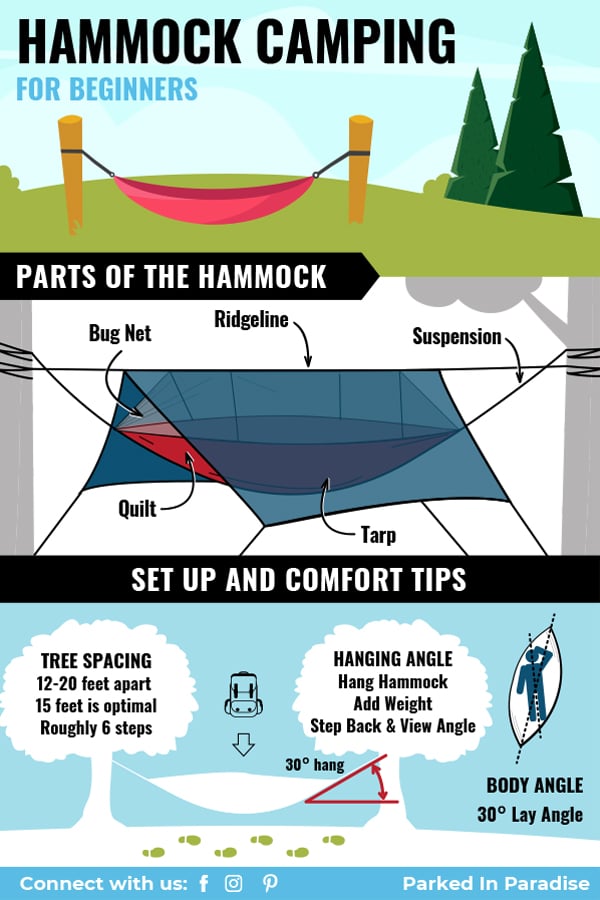
Hammock Camping Gear
If you’re ready to tackle hammock camping, it’s time to talk gear! Remember that hammocks are modular; meaning you can mix and match components. That makes them a satisfying piece of equipment for outdoor gear junkies.
Fortunately, there are plenty of all-in-one hammocks. So, if you don’t want to spend too much time (and money) studying components you can just purchase a ready-made hammock camping system.
These are the main pieces of hammock camping gear:
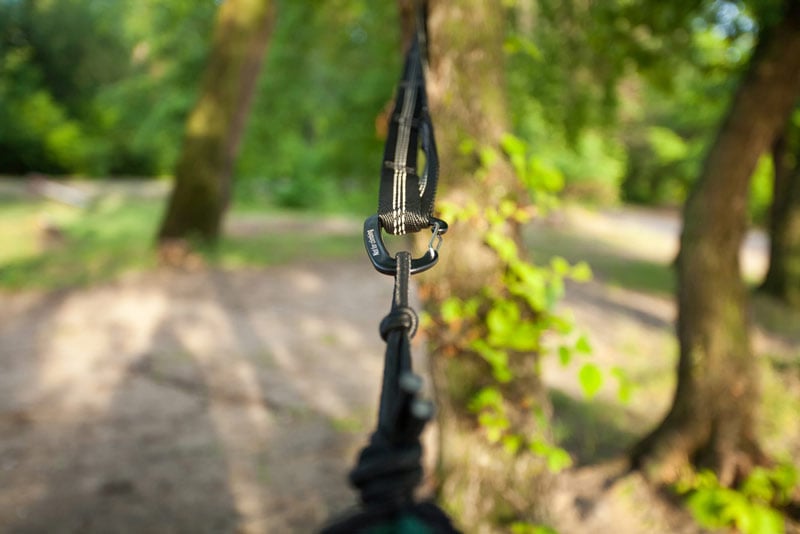
Suspension and Webbing Straps
A suspension system refers to webbing straps or suspension cords which are adjustable and string your hammock from tree to tree.
Webbing straps are best for outdoor camping because they are thicker and will protect tree bark from damage. They typically range from 1.5-2 inches wide and are made of polyester or polypropylene.
Daisy chain webbing straps have loops distributed down the length of the strap. These allow you to quickly and easily adjust the height of your hammock. Daisy chain straps are the best straps for beginners.
Suspension cords are cheaper and thinner than webbing. These are best for indoor use, or when hanging from a metal pole or inorganic object. Knot tying experience is required!
Ridgeline
The ridgeline (or guyline) stretches from tree to tree above the hammock to hold either bug netting or a tarp in place. Ridgelines are not necessary, but you wouldn’t want to be caught in a rainstorm without one!
A ridgeline should always be centered above the hammock with its anchor points positioned slightly below the suspension system. That keeps the additional layers close to the hammock and insulates you from the elements.
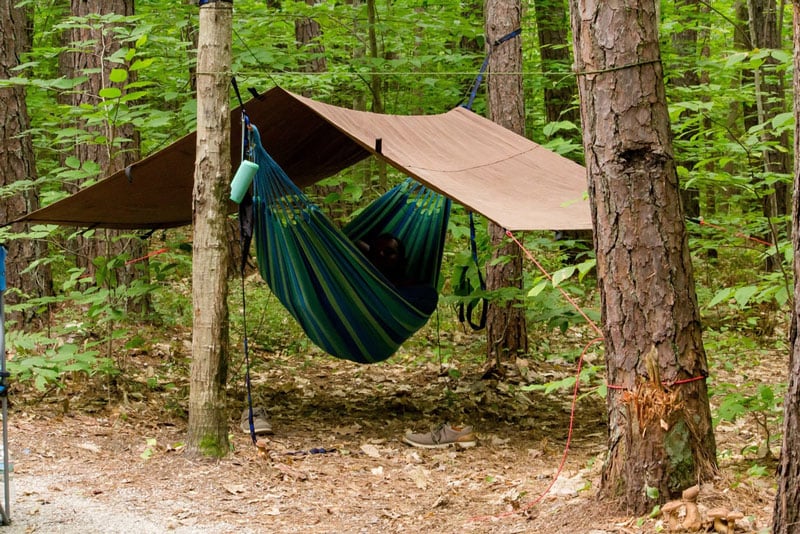
Tarp
Tarps can protect you from rain, snow, and provide shade on sunny days. A simple blue poly camping tarp is all you need to get basic fortification from the elements while you sleep at night.
Square tarps hang from the ridgeline above your hammock creating a diamond shape for moisture to roll off throughout the night. Fancier tarps that provide more insulation come in asymmetrical, hexagonal, and more complex forms for winter camping.
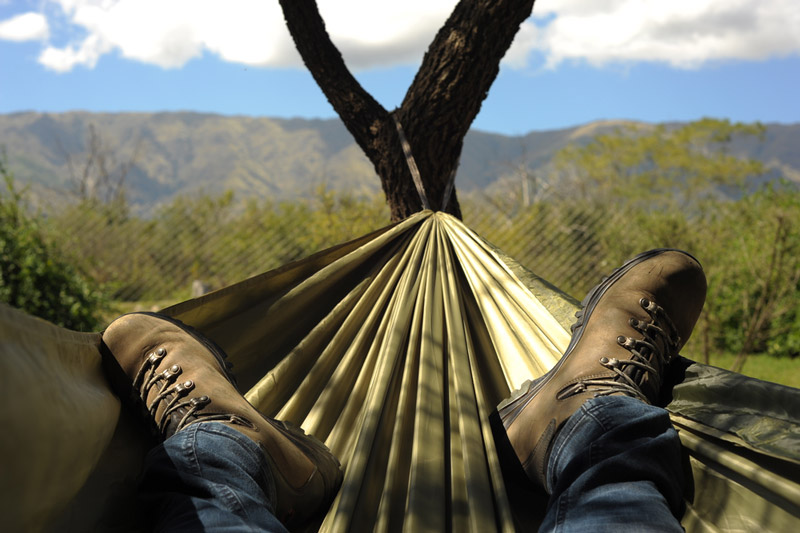
Bug Net
Bug netting is another layer that can be hung from the ridgeline below the tarp. Some hammock camping systems come with bug nets sewn-in, so you don’t have to pack a separate accessory.
The best bug nets come with a zipper entrance, so you don’t have to struggle your way in. You’ll want to make sure that the bug net is stretched so the loose fabric doesn’t rest on your skin–otherwise you can still get bit!
Some campers use bug nets with side pull-outs or poles to give them a roomer sleeping space. There are also netted tarps available which provide both rain and bug protection. These are standard tarps that have a “bug net perimeter” sewn to the sides creating a full shelter.
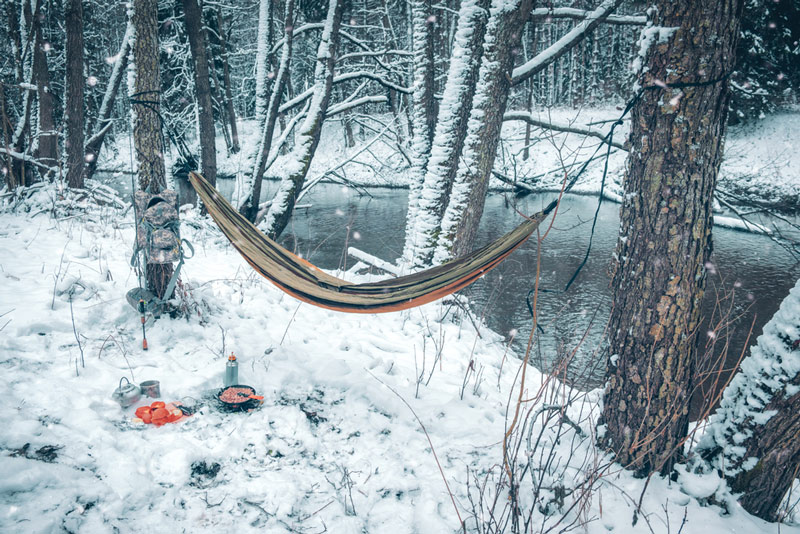
Quilt
Hammocks are considerably colder than sleeping in a tent. That’s great news for the summer months, but not so much in the spring and fall. Under quilts help keep you warm by insulating the backside of your body throughout the night.
Contrary to popular belief, a sleeping pad’s primary objective is to insulate from the cold; not make hammock set up more padded and comfortable–hammocks are already comfortable!
Sleeping pads and under quilts create an extra barrier between you and the outside air to prevent heat loss from below. When it comes to cold weather camping, the thicker the better. Down quilts perform best, but they are also the most expensive.
Your standard camping pad will also do just fine in a hammock. Some double-layered hammocks come with pad sleeves on the bottom to keep your sleeping pad nestled in place.
How To Choose A Hammock
The most important piece of hammock camping gear is… the hammock! Believe it or not, there is a huge variety of hammock types to choose from and they all serve different purposes. Listed below are some of the most common types.
Hammock Types
- Jungle hammocks
- Open-style hammocks
- Gathered end
- Spreader bar
- Bridge
- Single point hammocks
- Multi-point hammocks
Jungle hammocks are designed for camping. They have bug nets and sometimes rainflys included. You can mix and match your equipment according to preference. Many times, jungle hammocks can be purchased as an all-in-one system, making them convenient for the beginner hanger.
Open-style hammocks do not have bug nets or tarps included (of course, these can be added later). These are often the types of hammocks you’ll find in a backyard, at a pool-side lounge, or in a cozy reading nook.
Single-point hammocks are often used in mountaineering and climbing communities to anchor their bed to a cliff face while climbing.
Multi-point hammocks are also known as hammock tents. These are designed to house multiple campers. They typically have three or more attachment points
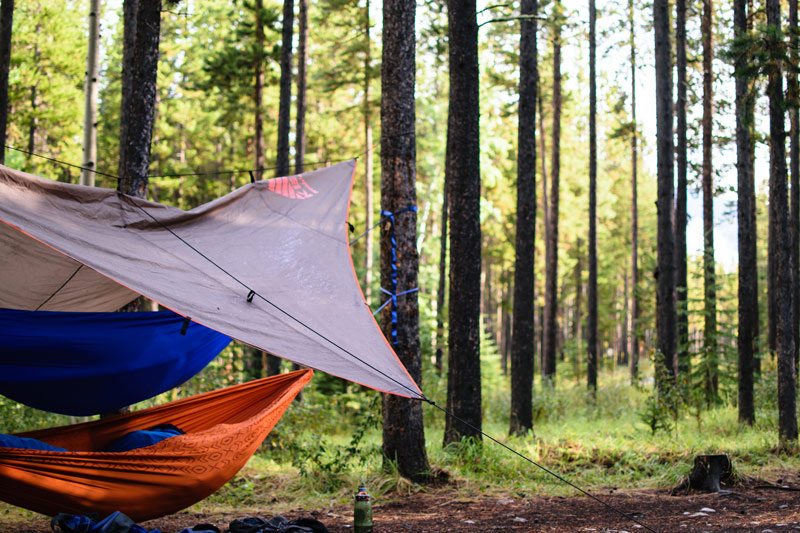
How To Hang A Camping Hammock
Hanging a hammock can be intimidating to the beginner; especially if you are not savvy with knots. Fortunately, modern hammock systems are very forgiving with their daisy chain straps and adjustable connectors.
If you want to avoid knots altogether, carabiners or cinch buckles are one of the quickest ways to get your sleep system assembled. Be sure to use a buckle capable of handling your weight–never trust your body to a plastic carabiner.
For the knot addicts of the group, there are any number of ties you can make to secure the hammock. Some of the most commonly used are the clove hitch or bowline.
How To Lay In A Hammock Comfortably
Believe it or not, achieving a comfortable hang is a science. It takes the right combination of tree spacing, hang angle, and appropriate gear. Over time you will find the most comfortable set up for your body. Once that happens, sleeping in a hammock will become more intuitive and comfortable than tent camping!
Tree Spacing
Trees should be spaced about 12-20 feet apart to get the most comfortable hang. You should avoid hanging longer distances because it makes your hang angle too shallow and stretches the suspension.
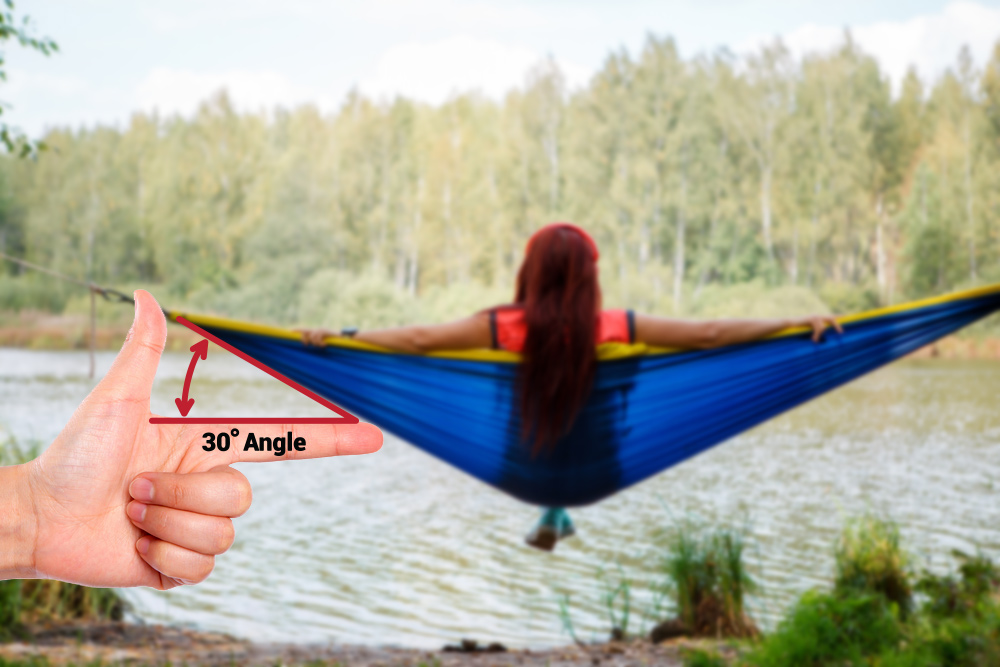
Hang Angle
Hang angle is going to be the biggest factor when it comes to comfort. You should aim for a 30 degree hang angle.
To find the proper hang angle:
- Hang your hammock
- Throw a little bit of weight in the center
- Take a step back
- Hold out your hand with the palm facing towards you, thumb up, and index finger straight out
- Adjust the suspension to create a 30° hang
Trees that are further apart require a slightly larger hang angle (up to 40 degrees). Trees that are closely spaced together will make your hammock more comfortable with a shallow angle (15 degrees or more).
Angling Your Body
A common misconception is that you should align your body parallel with the hammock when sleeping. Laying in this position is going to create tension in your back and hamstrings leading to an uncomfortable night of sleep.
Instead, you should angle your body at a 30° diagonal in relation to the hammock. This is going to create a flatter lay leading to a better night’s rest.
Hammock Camping Tips
- Position your hammock centered evenly between the two trees.
- Hang the ridgeline below the anchor points of the hammock. This will keep it close in case of inclement weather.
- When it comes to “tippy hammocks” use a guy line anchored to another tree or object on the ground to prevent excess movement.
- Hanging low or in areas surrounded by foliage will give you better protection from the wind.
Hammock Camping Safety
The #1 rule of hammock camping is to never hang a hammock higher than you’re willing to fall.
Additionally, make sure that all of your gear is in working order. Check that your suspension system is not fraying, the carabiners can hold the proper load, and that your knot tying is up to par.
Look for trees with a trunk at least 12 inches in diameter. If you can shake it–it’s probably too small. Always hang on live and mature trees. Make sure you look at the branches above you, not just the trunk. Falling branches are just as much of a danger as hanging on a dead tree.
Avoid lone trees or hanging from the tallest tree in the area if you suspect there will be a chance of lightning strikes.
Hang your food or any scented items when camping in bear territory or areas that may attract animals.
Watch out for poison ivy, poison oak, cacti or other dangerous plants. You don’t want to set up your hammock in an area where you’ll come in contact with these things in the middle of the night.
If you have the option, set up your hammock over softer grasses or flat ground rather than sharp rocks or water.
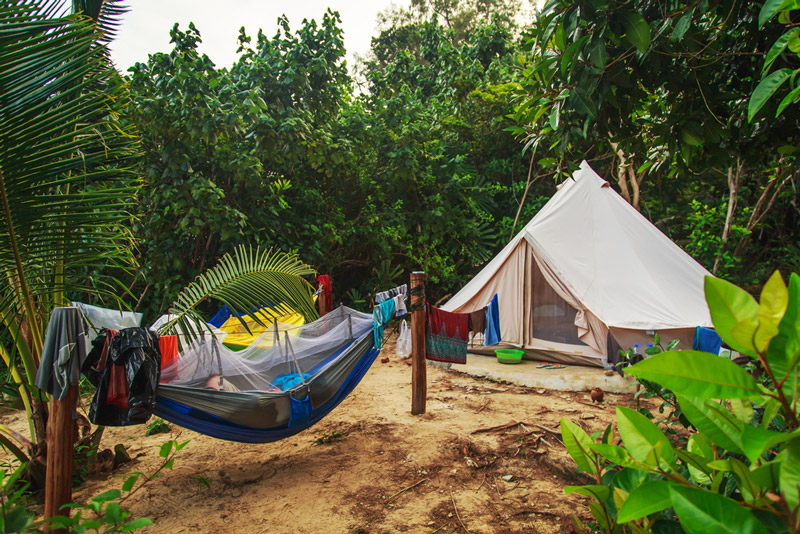
How To Hang A Hammock Without Trees
Just because you’re camping in the desert or somewhere with unsuitable trees doesn’t mean you have to give up on hammock camping! There are plenty of solutions that will allow you to hang comfortably in any environment.
Campgrounds
Not all campgrounds allow for hammock camping. This may be due to protected trees, or from past campers incorrectly hanging their hammocks. In some cases, the camp host may be able to direct you to areas where hammocks are permitted.
Campsite pavilions can be the perfect spot to hang. You’ll often find these in sunny desert areas to provide shade like at the Valley of Fire in Nevada for example.
Some campsites have poles that can be used specifically to anchor a hammock. If they do not, you may need to get creative. Tying one end of a hammock to your vehicle bumper, and the other end to a bear box might be an appropriate solution if it is sturdy enough.
Hammocks can be strung up in boats, inside of camper vans, or on docks. You can even use rock anchors if situated in mountainous terrain.
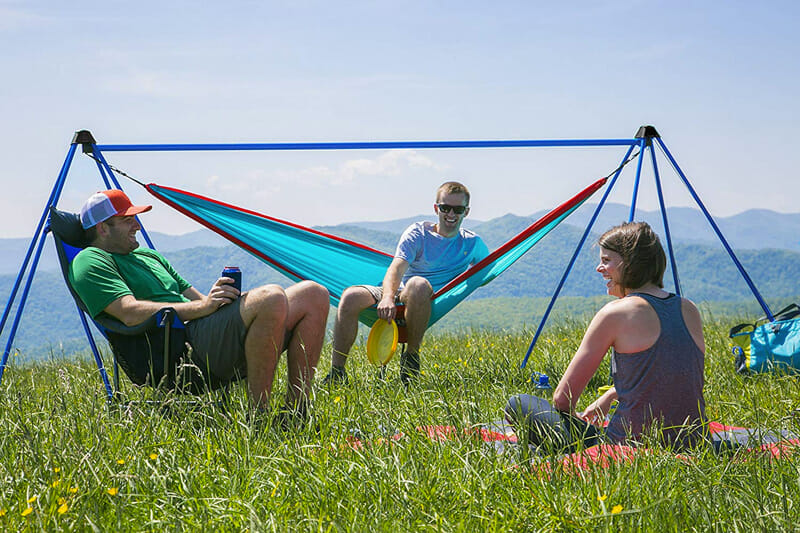
Hammock Stands
If you’re having a hard time finding anchors, or if you simply don’t want to deal with the unknown, you can always pack a portable hammock stand.
Some of these are designed specifically for camping and are lightweight and easy to pack in your car.
The Best All-In-One Camping Hammock Kits Reviewed
We certainly encourage campers to mix and match their equipment to get the most comfortable hang. But many times beginners don’t know where to start. So we recommend beginning with an all-in-one hammock kit. These systems are going to be low-cost and all of the gear is compatible with each other so hammock kits are the simplest way to start.
Camping hammock kits come with the following features:
- Hammock
- Bug net
- Rainfly
- Tree straps
- Suspension system
Under quilts and additional insulation are normally sold separately.
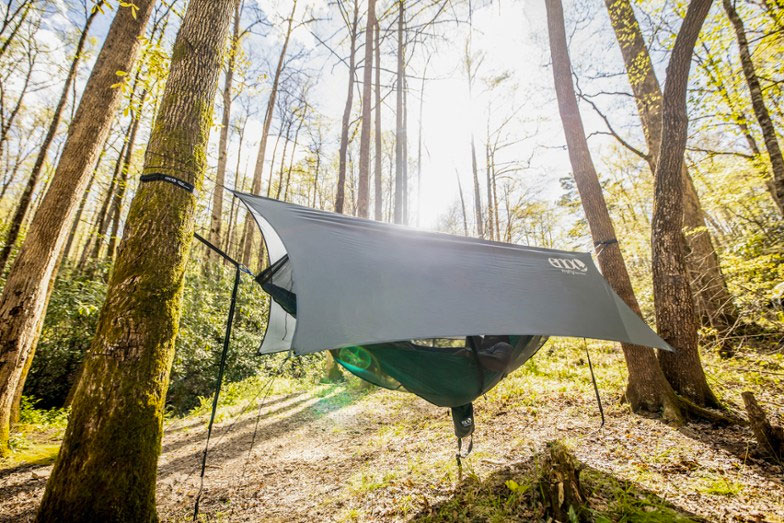
- 4 lbs 3 oz
- 400 lb weight capacity
- 30 adjustment points, no knots required
- 1% of proceeds go to environmental protection
Top Choice: Eagle’s Nest Outfitters Onelink Hammock Shelter
Eagle’s Nest Outfitters was founded in 1999 by a van dweller traveling the coast and sleeping in a hammock. Today it’s one of the premier hammock companies in the US. ENO contributes 1% of their revenue to non-profit organizations each year to help the planet.
Not only is ENO rooted in conservation, but they also make some awesome hammocks.
The OneLink Hammock Shelter combines the DoubleNest™ hammock,
The hammock shelter weighs 4 pounds, 3 ounces and can hold up to 400 pounds. The suspension system has over 30 adjustment points so you can get the most comfortable hang, and there are no knots required!
- 4 lbs 3 oz
- 400 lb weight capacity
- 30 adjustment points, no knots required
- 1% of proceeds go to environmental protection
- 3 lbs 3 oz
- 300 lb weight capacity
- Versatile design; can be used as a ground tent
Best For Backpacking: Hennessy Hammock Explorer Deluxe
If you’re looking for the most lightweight system to take backpacking, Hennessy hammocks take the cake. The Explorer Deluxe weighs only 3 pounds 3 ounces which is a whole pound lighter than the ENO!
A cool thing about the Hennessy is that this design can fold into an open-air lounger, or be used as a ground tent when paired with hiking poles. That makes it a versatile sleeping companion that you can take camping even when there are no trees.
- 3 lbs 3 oz
- 300 lb weight capacity
- Versatile design; can be used as a ground tent
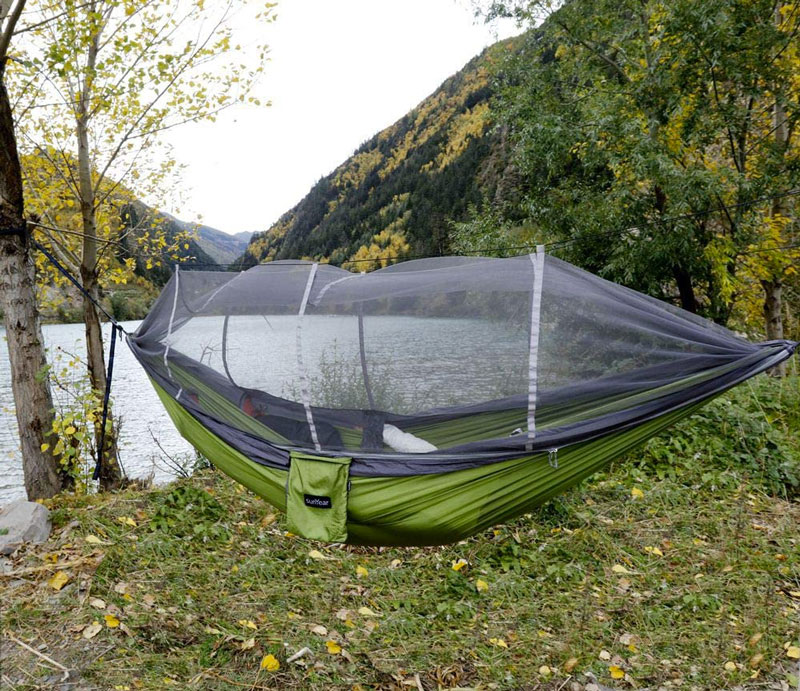
Most Budget-Friendly: SunYear Camping Hammock
If you’re looking to try hammock camping without breaking the bank, we recommend starting with something cheap like this hammock from SunYear. The hammock kit comes with all of the gear you need: a bug net, rainfly, suspension system, tree straps, and carabiners.
It’s lightweight and packs down small which is perfect for backpacking. The system is designed to hold up to 600 pounds so you can rest assured that it will sustain even the heaviest of campers, plus their gear!
- Inexpensive
- Great starter hammock
- 500-pound weight capacity
Give It A Shot!
Hammock camping is a unique experience and one that many people prefer over tent camping. While it can take some getting used to, hammocks have a lot of advantages over traditional sleeping gear.
If you’re looking for the best of the best, the Eagle’s Nest Outfitters hammock system combines the best gear you can buy. Hennessy makes the most lightweight hammock for backpacking, and SunYear has designed a good basic hammock set up for the beginner camper.

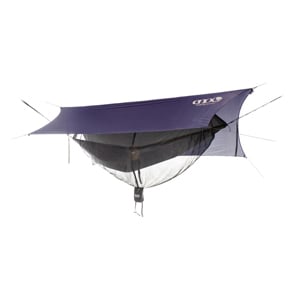
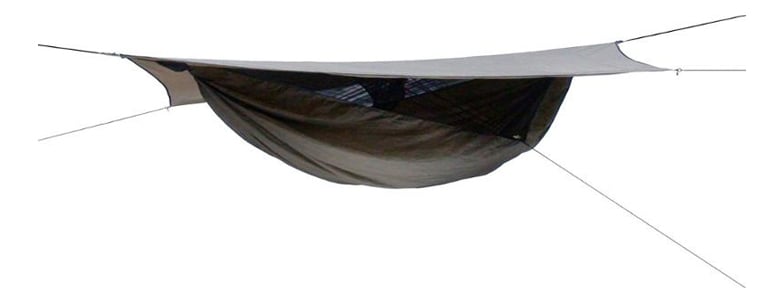
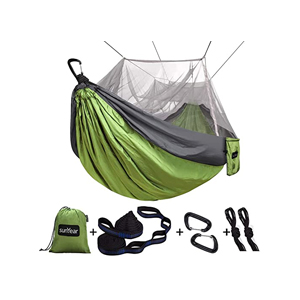
Comments (0)